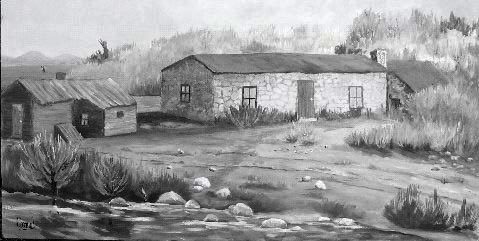(Contributed by the Thomas Tolman Family Organization. Excerpt from Judson Tolman: Pioneer, Lumberman, Patriarch by E. Dennis Tolman, Second Edition, 2004, pages 33-35).
Carma Renee Allred Jenkins, great granddaughter of Cyrus Tolman (1820-1890) and Margaret Eliza Utley (1835-1902) re-painted the Rush Valley homestead in September of 2005 with the following explanation:
“Five years ago I attempted to paint this picture but never was really satisfied with the results. Nothing looked right. As I was painting the hill behind the house something took hold of my brush and painted two girls, one tall and the other a small girl while I watched it move back and forth. I couldn’t believe what I was seeing. I finished the picture but painted over the girls because in the story Maggie said she watched the boys come across the desert from the top of the threshing machine shed. She might have done that some of the time but that is not how the girls wanted the picture to be painted. I feel that these sisters spent many hours sitting on the hill waiting for the distant dust that would mean their brothers were coming home.
“As I painted the picture my husband sat at my side making comments. He had been raised in a similar situation, three-room home, no amenities, poverty, struggle to survive. He felt the spirit of these people living on the desert and what it would have been like to haul water from a ditch, scrub clothes by hand, heat water and cook on a wood stove, freeze in the winter and pray for miracles. He felt the mood of the family on the desert and knew what needed to be changed on the picture to make it acceptable to the two girls that were watching me paint. It is very easy to see the boys could have ridden into the desert to find lost horses and how Martha and Maggie sat for many hours on the hill watching for their dust as they came across the desert. We need to trust in the communications that our ancestors have with us. They are much closer than we think.”
Carma continued, “Cyrus and Margaret’s family first lived in a three-room log home on this ranch until they bought an adobe house that was close to their log home. They moved one room of the log home onto the back end of the rock home leaving two rooms of the log home which were used by the boys as a bunk house.
“In exploring this area it was most interesting to observe just how lonely and remote the area was with no neighbors for many miles and nothing but sagebrush, dust and desert plants as far as the eyes could see. There was no chance for the children to go to school or to church because of the great distances and transportation. It is no wonder that little Maggie cried when
she saw pansies for the first time at the home of a lady in Ophir.
“The home was built in a wash against a hill that obscures the view of the valley. A little stream probably about 6 or 8 feet across runs east of the house and is fresh spring water. Walls of the adobe part of the home are still standing with a fireplace in the far north end of the kitchen area. A separate room is built into the hill north of the kitchen at an angle that was probably a storage room or cellar.
“The bunk house which is south of the main house is part of the original home where Maggie was born and there was a cellar underneath where an old iron stove was resting. On the south end of the bunk house we found old blacksmith tools and a forge.”
Visit FamilySearch to learn more about Margaret Eliza Utley, Also visit the Thomas Tolman Family Organization to find out how you can get more involved in family history.


